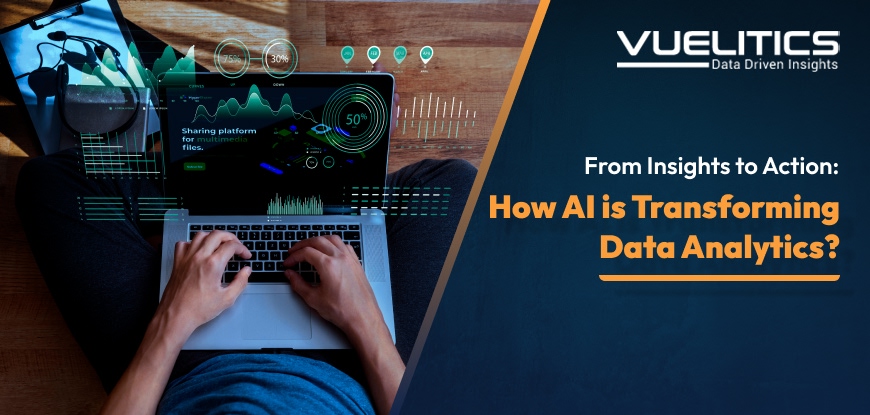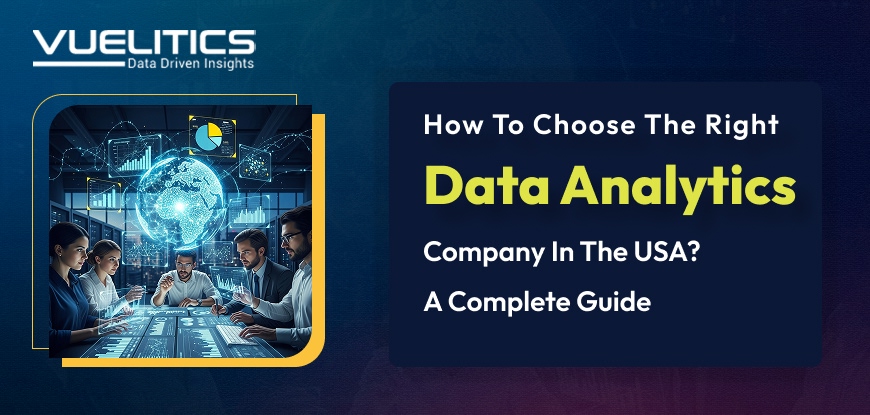- Home
- Blogs

From Insights to Action: How AI is Transforming Data Analytics?
More data has been collected and stored than ever before in the modern, data-driven economy. But it’s not just about collecting data; it’s about being able to make sense of that data in a timely manner so you can start making better decisions. Enter AI-enabled data analytics. When artificial intelligence data analysis and advanced statistical methods are combined, hidden patterns reveal themselves, outcomes become predictable, and the organization can act with surgical precision.
This tech is transforming industries from AI analytics in healthcare to AI analytics for retail, but not without calamitous means. In this article, we will try to discover some of its benefits and barriers to adopting AI for data analytics along with use cases to understand Its Potential.
What is AI-Powered Data Analytics?
In data analytics, artificial intelligence refers to the use of machine learning, deep learning, and other AI technologies for processing, interpreting, and analyzing massive datasets. Data analytics AI models are different in the sense that they learn from data and evolve with time, allowing them to adjust for the better based on new patterns rather than sticking to hard human-defined rules like traditional analytics.
Important elements of machine learning data analytics
- Preparing data for ingestion – Cleans up and formats raw datasets.
- Pattern recognition: Discovering trends and outliers.
- AI-based predictive analytics – Predicting what lies ahead
- Automating decision-making—suggesting or executing actions.
Advantages Of AI In Data Analytics
Find out how AI analytics helps transform business operations in ways that go far beyond just speed and accuracy. Now, back to the benefits… Begin by imagining these as the first few bright stars on your list:
Faster, Crisper Insights You Can Trust
Like seeing the correct answer in a single glance. AI-powered data analytics will quickly outstrip what we can do with human eyes, a job that might occupy any team of people for weeks on end can get finished in seconds, and all before your coffee cools…through sifting through thousands of pages. AI models are designed to investigate thousands or even millions of points at a time so they can detect things that a human—or an older algorithm—might miss, similar to hearing a slight echo within the general background noise in a room.
Predictive and Prescriptive Analysis
Predictive analytics powered by artificial intelligence can forecast market shifts, customer behavior, and trends. Prescriptive analytics goes even deeper, pointing out what you need to do to get the most beneficial outcome.
Automation of Repetitive Tasks
Why use AI for data analysis? One reason is automation. AI helps to automate cleaning data, handle exception cases, and generate reports, which greatly reduces manual intervention so that the team can focus on strategic work.
Enhanced Personalization
AI in Retail & Marketing: Customer behavior, recommendations based on personal behavior with highest engagement, and close sales.
Improved Decision-Making
Analytics-driven AI empowers and guides decision-makers to act in confidence, rationalizing that their strategies are backed by impartial data.
Challenges of AI Data Analytics
Now, while there are clear benefits to implementing AI in your data analytics implementation, it presents a few stumbling blocks for the businesses.
Data Integrity and Access Issues
The information datasets comprise will only be as precise as the datasets data inputs and dimensions for the artificial intelligence’s information scrutiny. Artificial intelligence systems are restricted based on datasets that have been published.
High Implementation Costs
AI and data analytics development and deployment can be pricey, especially for small businesses without the corresponding skills in-house.
Talent Shortages
The reality is that there simply aren’t enough machine learning data analytics professionals to go around, which is hurting AI adoption globally.
Ethical and Privacy Concerns
AI Analytics Ethical Issues: Biased algorithms, Improper use of personal data, and non-transparent decision-making.
Security Threats
A cyberattack poses a major threat to data analytics with AI since they can either manipulate the data or trick the AI model(s) into producing inaccurate output.
Real-World AI Data Analytics Examples
AI Analytics in Healthcare
Hospitals leverage AI data analytics to forecast patient readmission likelihoods, identify diseases sooner and propose customized treatment paths. In another example, AI models can review MRI scans more quickly than radiologists and thus speed up the time to diagnosis.
AI Analytics in Finance
Banks and fintech companies use AI prediction analytics in fraud detection, credit scoring (technology based on alternative data that can improve unsecured loans), and recommendations for investment. So, AI models are able to detect this kind of unusual transaction pattern within a fraction of a second, which ends up preventing a huge financial loss.
AI Analytics for Retail
Demand forecasting, inventory optimization, and customer segmentation are some examples of the types of artificial intelligence analytics that can be used in retail. Benefits of AI Analytics: Retailers leverage use cases. AI-powered recommendation engines drive more targeted promotions and cross-selling.
AI in Marketing Analysis
Combining data analytics and AI lets marketers track campaign performance, explore customer sentiment analysis, and tweak ad spending in real time for better ROI.
Why Use AI for Data Analysis?
- Speed—The speed to analyze large datasets in seconds.
- The goal of precision is to reduce the likelihood of making errors in decision-making.
- Flexibility—Models get better with data over time.
- Scalability—Easy to manage increased volumes of data without putting up cost.
The Future of AI Analytics
The future of AI-powered data analytics is one that is more accessible and explainable and points to the reality of wider business integration once AI matures. These efforts will work to minimize bias, promote graduated autonomy, and increase transparency, making these advanced AI companions fairer and more trustworthy and ensuring they adhere to the legal frameworks of our collective future.
FAQ: AI-Powered Data Analytics
What is AI-powered data analytics?
It is nothing but the way of AI and machine learning to process a huge amount of data, find patterns in those data, and churn out useful statistics at a faster pace with lesser room for errors than any human could do.
What obstacle does AI data analytics face?
Such AI data analytics downsides are often related to general data issues, high implementation costs, lack of expertise (shortages), ethical considerations, and security threats.
What benefits does AI provide to health data analytics?
AI analytics in healthcare can be used for early diagnosis. Predictive patient outcomes Optimized hospital operations Personalized treatments
Do only big companies use AI in data analytics?
No. Although the adoption of AI in data analytics initially began with large enterprises, cloud-based AI analytics tools now make this technology accessible to smaller and mid-sized businesses.
Can you provide some examples of AI data analytics in action?
Examples are in finance/prudential computing for fraud detection, retail/e-commerce recommendation engines, manufacturing/PdM (predictive maintenance), and marketing/socionomics (sentiment analysis).



Post Comments